Citrus
Published 2010-12-01
Keywords
- mechanical harvesting,
- abscission,
- harvest efficiency,
- 5-chloro-3-methyl-4-nitro-1H-pyrazole
Abstract
This study was conducted to determine the change in mechanical harvest efficiency over time of sweet orange treated with the abscission agent 5-chloro-3-methyl-4-nitro-1H-pyrazole (CMNP). CMNP was applied in December on ‘Hamlin’ at 0 and 300 mg·L–1 in a carrier volume of 2806 L·ha–1. The trees were harvested 2, 3, 4, and 6 d after CMNP application with a pull-behind canopy shaker operating at 3.7 Hz and with a tractor speed of 1.6 km·h–1. Fruit detachment force of CMNP-treated fruit declined to 39 N, which was 40% lower than the controls, by 4 d after CMNP application. The percent of fruit drop increased to 5% for CMNP treated fruit by 4 d compared to the controls that were significantly lower with 1% drop. The CMNP × harvest day interaction for the percentage of the crop removed by the harvester was not significantly different. The CMNP main effect mean was significant with CMNP removing 73% of the crop compared to 68% for the controls. The widest separation between CMNP treated and controls trees for the amount of fruit left in the trees after mechanical harvest occurred on day 4, where only 23% of the crop had to be gleaned for CMNP-treated trees compared to the controls that required 36% of the crop to be removed by hand. This study demonstrated that CMNP was active up to 4 d after CMNP application with the concentration and carrier volume of CMNP as used here and with air temperatures optimum for loosening (>15.6 °C) for most of the loosening period.References
- Alferez, F., S. Shila, A.L. Umback, B. Hockema, and J.K. Burns. 2005. Citrus abscission and arabidopsis plant decline in response to 5-chloro-3-methyl-4-nitro-1H-pyrazole are mediated by lipid signaling. Plant Cell Environ. 28:1436–1449.
- BenSalem, E., M. Salyani, and J.D. Whitney. 2001. Spray variable effects on deposition and harvesting efficacy of CMN-pyrazole. Proc. Fla. State Hort. Soc. 114:111–118.
- Burns, J.K., R.S. Buker III, and F.M. Roka. 2005. Mechanical harvesting capacity in sweet orange is increased with an abscission agent. HortTechnology 15:758–765.
- Burns, J.K., F.M. Roka, K.T. Li, L.V. Pozo, and R.S. Buker, III. 2006. Late-season ‘Valencia’ orange mechanical harvesting with an abscission agent and low-frequency harvesting. HortScience 49:341–346.
- Ebel, R.C. and J.K. Burns. 2008. Incorporation of air temperature into a model that predicts loosening of sweet oranges by CMNP. Fla. State Hort. Soc. Proc. 121:160–163.
- Ebel, R.C., J.K. Burns, and K. Morgan. 2009. Spray volume distribution and effect of 5-chloro-3-methyl-4-nitro-1H-pyrazole for loosening sweet oranges using a vertical, multiple fan. HortScience 44:1895–1899.
- Ebel, R.C., J. Burns, K. Morgan, and F. Roka. 2010. Abscission agent application and canopy shaker frequency effects on mechanical harvest efficiency of sweet orange. HortScience 45:1079–1083.
- Farooq, M., M. Saylani, and J.D. Whitney. 2003. Effect of application techniques on abscission chemical deposition and mechanical harvesting of ‘Valencia’ oranges. HortTechnology 13:344–350.
- Freeman, B. and R.A. Sarooshi. 1976. Abscission chemicals for Valencia oranges in New South Wales. Austral. J. Expt. Agr. Animal Husb. 16:943–949.
- Kender, W.J. and U. Hartmond. 1999. Variability in detachment force and other properties of fruit within orange tree canopies. Fruit Var. J. 53:105–109.
- Koo, Y.M., M. Salyani, and J.D. Whitney. 1999. Effects of abscission chemical spray deposition on mechanical harvest efficacy of ‘Hamlin’ orange. Proc. Fla. State Hort. Soc. 112:28–33.
- Koo, Y.M., M. Salyani, and J.D. Whitney. 2000. Spray variable effects on abscission of orange fruit for mechanical harvesting. Trans. Amer. Soc. Agr. Eng. 43:1067–1073.
- Pozo, L., R. Yuan, I. Kostenyuk, F. Alferez, G.Y. Zhong, and J.K. Burns. 2004. Differential effects of 1-methylcyclopropene on citrus leaf and mature fruit abscission. J. Amer. Soc. Hort. Sci. 129:473–478.
- Sharma, S., R.C. Ebel, and K.T. Morgan. 2010. Modeling loosening of sweet orange with CMNP: Variation in fruit detachment force. Proc. Fla. State Hort. Soc. 123:39–43.
- Salyani, M., E. BenSalem, and J.D. Whitney. 2002. Spray deposition and abscission efficacy of CMN-pyrazole in mechanical harvesting of Valencia orange. Trans. Amer. Soc. Agr. Eng. 45:265–271.
- Whitney, J.D. and S.L. Hedden. 1973. Harvesting Valencia oranges with a vertical foliage shaker. Proc. Fla. State Hort. Soc. 86:41–48.
- Yuan, R. and J.K. Burns. 2004. Temperature factor affecting the abscission response of mature fruit and leaves to CMNP-pyrazole and ethephon in ‘Hamlin’ orange. J. Amer. Soc. Hort. Sci. 129:287–293.

